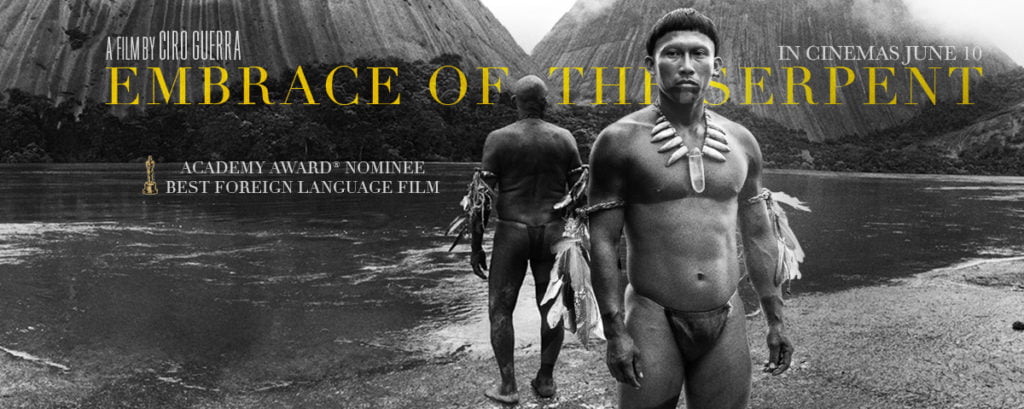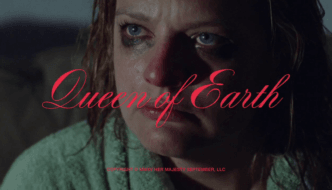Review: Embrace of the Serpent directed by Ciro Guerra
July 4, 2016

Halfway through the year, there are a number of films which seem likely to figure in year-end polls. The discussion will almost certainly include The Revenant, The Big Short, Spotlight, Anomalisa, High-Rise, The Club, Midnight Special, Son of Saul, Mustang and Weiner. But eclipsing them all is Embrace of the Serpent. Colombian director Ciro Guerra’s Oscar-nominated third feature blends fact and fiction to chart the 1909 and 1940 Amazonian expeditions of German ethnologist Theo Koch-Grünberg (Jan Bijvoet) and American biologist Richard Evans Schultes (Brionne Davis). Both men are in search of the rare and sacred yakruna plant, which is believed to possess healing properties. They are helped in their search by Karamakate (Nilbio Torres and Antonio Bolivar), an Amazonian shaman whose tribe has been wiped out by Colombian rubber interests and who wanders the jungle alone.
 It would do a disservice to a film this stunning to reduce it to a list of influences, but there are clear forebears: Embrace of the Serpent bears a trace of Tarkovsky’s Andrei Rublev (1966) in its breathtaking black and white photography; it has the hallucinatory quality of Jodorowsky at his best; the ‘ecstatic truth’ of Herzog’s various meditations on colonial folly; even the operatic bravura of Coppola’s Apocalypse Now (1979). But Guerra never pays undue fealty to any of these, and Embrace of the Serpent stands equal to such pillars of world cinema. What sets Embrace of the Serpent apart from the majority of films which seek to address the wounds of colonialism is the fact that it tells the story from an indigenous point of view. Guerra collaborated closely with the indigenous population, and the result is a film which recreates and honours a lost epoch; those tribes whose songs we will never hear.
It would do a disservice to a film this stunning to reduce it to a list of influences, but there are clear forebears: Embrace of the Serpent bears a trace of Tarkovsky’s Andrei Rublev (1966) in its breathtaking black and white photography; it has the hallucinatory quality of Jodorowsky at his best; the ‘ecstatic truth’ of Herzog’s various meditations on colonial folly; even the operatic bravura of Coppola’s Apocalypse Now (1979). But Guerra never pays undue fealty to any of these, and Embrace of the Serpent stands equal to such pillars of world cinema. What sets Embrace of the Serpent apart from the majority of films which seek to address the wounds of colonialism is the fact that it tells the story from an indigenous point of view. Guerra collaborated closely with the indigenous population, and the result is a film which recreates and honours a lost epoch; those tribes whose songs we will never hear.
 Embrace of the Serpent is one of the most astute and nuanced readings of imperialism ever committed to the screen. Guerra makes little distinction between the rubber barons and the Capuchin friars who subjugated and exploited the Amazonian tribes in the name of ‘civilizing’ them; and sees in this collusion striking parallels with current resource wars. There is the interaction of science and superstition, reason and spirituality, progress and tradition; but also an understanding that these interactions should be an equal exchange. There is a mysticism at the film’s core, but one grounded in an awareness of the function this plays in the daily lives of indigenous people. This is coupled with an almost documentary level of naturalism; with Guerra casting indigenous people in the majority of the roles, and cinematographer David Gallego capturing the essence of the jungle by stripping it of its scenic qualities; its inky rivers snaking through what functions as the film’s lone female, and most powerful, character. The cliché of location functioning as character has never been truer than it is here.
Embrace of the Serpent is one of the most astute and nuanced readings of imperialism ever committed to the screen. Guerra makes little distinction between the rubber barons and the Capuchin friars who subjugated and exploited the Amazonian tribes in the name of ‘civilizing’ them; and sees in this collusion striking parallels with current resource wars. There is the interaction of science and superstition, reason and spirituality, progress and tradition; but also an understanding that these interactions should be an equal exchange. There is a mysticism at the film’s core, but one grounded in an awareness of the function this plays in the daily lives of indigenous people. This is coupled with an almost documentary level of naturalism; with Guerra casting indigenous people in the majority of the roles, and cinematographer David Gallego capturing the essence of the jungle by stripping it of its scenic qualities; its inky rivers snaking through what functions as the film’s lone female, and most powerful, character. The cliché of location functioning as character has never been truer than it is here.
Embrace of the Serpent has the quality of a fever dream, but one from which you emerge with a new understanding of yourself and the world. Its hypnotic beauty connects on a deeper level of consciousness, harnessing the traditions of Amazonian myth to take a step beyond the bounds of conventional storytelling, creating something that approaches a spiritual quest. Like the photographs which inspired its aesthetic, Embrace of the Serpent captures a world that will soon be gone; Guerra is continuing a tradition, a dialogue with the Amazon. It is rare for a film to leave such a profound impression. It is rare that a film can be said to have ‘changed’ its audience in any meaningful way. Embrace of the Serpent is such a film.
Follow Daniel Palmer on Twitter at @mrdmpalmer.
Filed under: Film, TV & Tech
Tagged with: Amazon, Colombia, Coppola, david gallego, film, Guerra, Herzog, indigenous, Jodorowsky, Tarkovsky



Comments